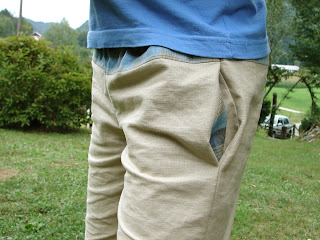I had a wonderful vacation and a few lovely weeks of procrastination after it. But I'm back now, with a regular posting schedule.
When I was away, I came up with a list of more or less necessary sewing tools. Because pressing is as important as sewing itself, the first two are pressing aids - tailor's hem and seam roll. You should press each seam after you stitch it or you'll end up with a garment that looks sloppy.
 |
| The side edges of my ham and roll wrinkle - that means that they aren't filled/firm enough. |
Tailor's ham (or pressing ham) is used for pressing curved areas, e.g. princess seams, darts, collars, sleeve caps etc. Just shape it into a desired shape and use it wherever you need to. One side is covered in cotton (for pressing cotton with higher temperatures) and the other one in wool (for pressing wool with lower temperatures).
Seam roll is used for pressing long narrow seams and is an alternative to a sleeve board. It helps you with pressing sleeves and areas of a garment that are difficult to reach. It's especially convenient for pressing seams open, because of it's shape which prevents marks of seam allowances showing on the right side of the fabric.
I made the shape for the ham by the help of
this tutorial and filled it with sawdust. I should fill it with finer sawdust (almost like powder, which would make the ham firmer), but I didn't have any at hand. It works fine for now, but I'm probably going to open it once the sawdust subsides, empty it, and fill it with the powder. For the seam roll I cut rectangles 32 x 12 cm or 12-5/8 x 4-3/4 in. The measurements include 1 cm or 3/8 in. seam allowance. You can make the corners round, just as I did, or even rounder.
1. Cut three in cotton (white+pink stripes fabric is for lining) and one in wool.
2. Stitch right sides together - including the lining which is facing the
wrong side of each of the outside fabrics. Leave a gap open - I
recommend you leave it on the narrower side of the ham/roll.
3. Make notches
halfway into the seam allowances on all curved areas.
4. Turn inside out.
5. Fill with sawdust powder (I helped myself with a cut plastic bottle with
larger opening). When you think it's full - it's not. Use a handle of a kitchen ladle to stuff the ham a little more. It must be firm.
6. When you're done with filling, stitch the opening with hand stitches.





































